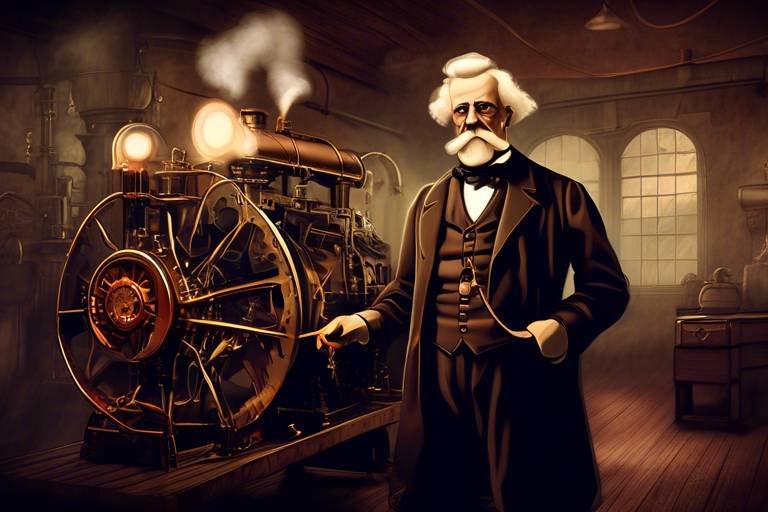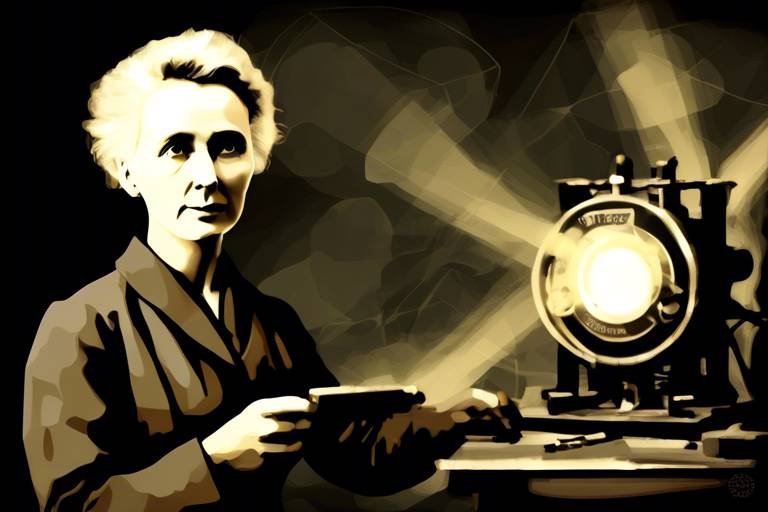Watt: The Inventor of the Steam Engine
James Watt, the brilliant mind behind the revolutionary steam engine, forever changed the course of history with his innovative creations. His journey from humble beginnings to becoming the inventor of the steam engine is a tale of perseverance, creativity, and ingenuity that continues to inspire generations.

Early Life and Education
James Watt, the renowned inventor of the steam engine, was born on January 19, 1736, in Greenock, Scotland. Growing up, Watt showed a keen interest in mathematics and engineering, often tinkering with gadgets and machinery in his free time. His early exposure to the world of mechanics laid the foundation for his future groundbreaking inventions.
Watt's educational journey began at the University of Glasgow, where he studied instrument making and mathematical principles. His time at the university honed his analytical skills and deepened his understanding of physics, setting the stage for his revolutionary work in the field of steam power.
After completing his studies, Watt apprenticed as a mathematical instrument maker, where he further refined his technical skills and gained practical experience in working with precision instruments. This hands-on training proved invaluable in shaping his approach to problem-solving and innovation.
One pivotal moment in Watt's early life was his encounter with a model Newcomen steam engine in need of repair. Intrigued by the machine's inefficiency, Watt embarked on a mission to improve its design and functionality. This encounter marked the beginning of his quest to revolutionize the steam engine and propel the Industrial Revolution forward.
Driven by curiosity and a relentless pursuit of knowledge, Watt delved into the intricacies of steam power, conducting experiments and research to enhance the engine's performance. His relentless dedication to innovation and improvement set him apart as a visionary in the field of mechanical engineering.

Improvements on Existing Designs
James Watt, a pioneer in the field of engineering, is renowned for his groundbreaking invention of the steam engine. His innovative improvements revolutionized the industrial landscape and paved the way for modern technological advancements.
James Watt's contributions to the development of the steam engine were truly transformative. He made significant enhancements to the existing Newcomen steam engine, which was inefficient and limited in its capabilities. By introducing a separate condenser and implementing a rotary motion, Watt was able to vastly improve the engine's efficiency and power output.
These improvements had a profound impact on the Industrial Revolution, enabling industries to increase productivity and expand their operations. Watt's innovations not only revolutionized manufacturing processes but also facilitated the growth of transportation networks, ultimately shaping the modern world as we know it.
His refined steam engine design was a catalyst for progress, driving innovation across various sectors and laying the foundation for further technological advancements. Watt's relentless pursuit of perfection and his ingenuity in refining existing designs set him apart as a visionary in the realm of engineering.

Collaboration with Boulton
James Watt's collaboration with Matthew Boulton proved to be a pivotal moment in the history of industrial innovation. The partnership between these two visionaries was a harmonious blend of engineering expertise and entrepreneurial spirit. Boulton, a skilled manufacturer, recognized the potential of Watt's steam engine improvements and saw an opportunity to revolutionize industries.
Together, Watt and Boulton established the renowned Soho Foundry in Birmingham, a hub of technological advancement and industrial production. This collaboration not only led to the mass production of Watt's improved steam engines but also facilitated the spread of this groundbreaking technology across various sectors.
The synergy between Watt and Boulton was instrumental in driving the industrial revolution forward. Their combined efforts not only enhanced the efficiency of steam engines but also spurred innovation in manufacturing processes. The Soho Foundry became a symbol of progress and ingenuity, attracting skilled craftsmen and engineers from all corners of the world.
Furthermore, Boulton's business acumen complemented Watt's technical brilliance, creating a dynamic duo that propelled the steam engine to new heights of success. Their collaboration was not merely a partnership of convenience but a true meeting of minds, united by a shared vision of transforming the industrial landscape.

Patent Battles and Success
James Watt faced significant challenges in protecting his patents for the steam engine, leading to intense legal battles that tested his resolve and determination. The *success* of Watt's innovations was not without obstacles, as he encountered fierce opposition from competitors who sought to replicate his groundbreaking designs without permission or acknowledgment.
Despite these *patent battles*, Watt persevered and ultimately secured the legal protection necessary to ensure that his inventions were recognized and rewarded. His triumph in defending his intellectual property rights not only solidified his legacy as a pioneering inventor but also set a precedent for future innovators to safeguard their creations.
Through his relentless pursuit of justice and unwavering commitment to his craft, James Watt emerged victorious in the face of adversity, establishing himself as a *trailblazer* in the field of engineering and industrial development. His ability to navigate the complexities of patent law and emerge triumphant underscored his ingenuity and foresight in revolutionizing the technological landscape.

Legacy and Influence
James Watt's legacy and influence in the realm of technological innovation are profound and far-reaching, shaping the course of history and revolutionizing various industries. His invention of the steam engine not only propelled the Industrial Revolution but also laid the foundation for modern transportation and manufacturing processes.
Watt's steam engine was a game-changer, providing a more efficient and reliable source of power that replaced traditional methods, such as water and wind mills. This innovation led to exponential growth in industries like textile manufacturing, mining, and transportation, fueling economic development and societal advancements.
Moreover, Watt's improvements on the steam engine not only increased its efficiency but also made it more versatile, allowing for its application in diverse fields beyond just pumping water from mines. The widespread adoption of Watt's steam engine accelerated progress and set the stage for further technological breakthroughs.
His partnership with Matthew Boulton was instrumental in bringing his inventions to fruition and establishing the renowned Soho Foundry. Together, they not only manufactured steam engines but also promoted their use across various industries, solidifying Watt's reputation as a pioneering engineer and inventor.
The impact of Watt's steam engine extended beyond his lifetime, influencing subsequent generations of inventors and engineers. His innovative spirit and dedication to continuous improvement set a benchmark for technological advancements, inspiring future innovations in engineering and industry.
Even today, the principles underlying Watt's steam engine remain relevant in modern engineering practices, serving as a testament to his enduring legacy. The foundational concepts he introduced continue to shape the design of machinery and power systems, underscoring the timeless relevance of his contributions.
James Watt's legacy endures as a testament to the power of innovation and the transformative impact of technological advancements. His pioneering work in developing the steam engine not only revolutionized industries during his time but also laid the groundwork for the technological landscape we inhabit today.

Personal Life and Later Years
James Watt, the ingenious inventor behind the revolutionary steam engine, had a personal life and later years filled with both challenges and triumphs. Despite his dedication to innovation, Watt faced personal struggles and setbacks that shaped his journey outside of the realm of engineering.
Throughout his later years, Watt found solace in his family life, cherishing moments spent with his loved ones amidst the chaos of his groundbreaking work. His dedication to his craft often meant sacrificing personal time, but he always made time for his family, finding balance between his passion for invention and his personal relationships.
As Watt's fame grew and his inventions gained widespread recognition, he navigated the complexities of newfound success with humility and grace. Despite the pressures of the spotlight, Watt remained true to his values and continued to push the boundaries of technological innovation, leaving a lasting legacy that transcended his lifetime.
In his later years, Watt reflected on his journey with a sense of fulfillment, knowing that his contributions had forever changed the course of history. His relentless pursuit of excellence and unwavering determination served as an inspiration to future generations of inventors and innovators, cementing his place in the annals of scientific achievement.
As Watt's legacy continues to shape the modern world, his personal life and later years serve as a testament to the power of perseverance and passion. Through his dedication to his craft and his unwavering commitment to excellence, James Watt not only revolutionized industries but also left an indelible mark on the fabric of human progress.

Recognition and Honors
James Watt, the brilliant mind behind the steam engine, was not only revered during his time but continues to be celebrated for his groundbreaking contributions to the industrial revolution. His innovative spirit and dedication to improving the efficiency of steam power did not go unnoticed, earning him a plethora of recognition and honors that solidified his place in history.
One of the most prestigious accolades bestowed upon Watt was his appointment as a Fellow of the Royal Society in 1785. This honor recognized his exceptional achievements in the field of engineering and highlighted his significant impact on the scientific community. Watt's induction into this esteemed society solidified his reputation as a pioneering inventor and thinker.
Furthermore, Watt's collaboration with Matthew Boulton, a prominent entrepreneur and industrialist, led to the establishment of the Soho Foundry in Birmingham. This partnership not only revolutionized manufacturing processes but also garnered widespread acclaim for their innovative approach to engineering. Their joint efforts were recognized with numerous awards and accolades, showcasing the duo's remarkable ingenuity.
As Watt's steam engine began to power industries and transform transportation systems, his influence spread far and wide. In recognition of his immense contributions, the British government granted Watt a patent extension in 1775, ensuring that he received due credit for his revolutionary invention. This extension solidified Watt's position as a pioneering figure in the history of technological advancements.
Moreover, Watt's legacy was further honored through the establishment of the Watt Medal by the Institution of Civil Engineers in 1937. This prestigious award is presented to individuals who have made significant contributions to the field of engineering, embodying the innovative spirit and visionary thinking exemplified by James Watt himself. The creation of this medal serves as a lasting tribute to Watt's enduring legacy.
In conclusion, James Watt's remarkable achievements in the realm of engineering and innovation have been rightfully acknowledged through a myriad of recognition and honors. His pioneering work on the steam engine not only revolutionized industries during the industrial revolution but also laid the foundation for modern technological advancements. Watt's enduring legacy continues to inspire future generations of inventors and engineers, solidifying his place as a true visionary in the annals of history.

Technological Innovations Beyond Steam Engine
James Watt, known for his revolutionary steam engine, was not only a pioneer in steam power but also a versatile inventor with technological innovations that extended beyond his iconic creation. Beyond the steam engine, Watt made significant contributions in various fields, showcasing his ingenuity and forward-thinking mindset.
One notable technological innovation beyond the steam engine was Watt's development of the centrifugal governor, a device that automatically controls the speed of an engine. This invention played a crucial role in regulating the speed of machinery, ensuring efficiency and safety in various industrial processes.
In addition to the centrifugal governor, James Watt also delved into the realm of instrumentation and measurement. He designed and improved instruments such as the micrometer and the indicator diagram, which were instrumental in precision engineering and scientific advancements.
Watt's innovative spirit extended to the field of chemistry as well. He conducted experiments on liquefaction of gases and made significant contributions to our understanding of gas properties, paving the way for further developments in the field of chemistry and industrial applications.
Furthermore, James Watt's expertise in mechanical engineering led to advancements in rotary motion mechanisms. His designs and improvements in rotary engines and mechanical linkages contributed to the evolution of machinery and automation, influencing various industries.
Watt's technological innovations beyond the steam engine exemplify his multidisciplinary approach and visionary mindset. His diverse contributions across different fields underscore his lasting impact on technology and innovation, solidifying his legacy as one of the most influential inventors in history.

Historical Significance and Continued Relevance
James Watt's invention of the steam engine holds immense historical significance and continues to be relevant in today's technological landscape. The steam engine revolutionized industries, transportation, and manufacturing during the Industrial Revolution, paving the way for modern advancements. Watt's innovative design not only increased efficiency but also sparked a wave of progress that shaped the world as we know it.
By harnessing the power of steam, Watt's invention enabled machines to perform tasks that were previously labor-intensive, leading to increased production and economic growth. The steam engine's impact on society was profound, triggering a shift towards mechanization and setting the stage for further technological developments.
Watt's steam engine played a crucial role in propelling the Industrial Revolution forward, driving innovation across various sectors. Its influence extended beyond the 18th century, laying the groundwork for the development of modern machinery and infrastructure. The principles underlying Watt's invention continue to underpin many aspects of contemporary engineering and design.
Today, the legacy of James Watt lives on in the form of his steam engine's continued relevance in powering industries and driving progress. While advancements in technology have led to the creation of more sophisticated machinery, the fundamental concepts introduced by Watt remain integral to many modern inventions.
As we look back on the historical significance of Watt's steam engine, we also recognize its enduring impact on the world we inhabit today. The steam engine's evolution from a groundbreaking innovation to a symbol of industrial prowess serves as a testament to human ingenuity and the power of technological advancement.
Frequently Asked Questions
- What was James Watt's most significant invention?
James Watt is most renowned for his invention of the steam engine, which played a pivotal role in the Industrial Revolution, transforming industries and transportation.
- How did James Watt's improvements on the steam engine impact society?
Watt's enhancements to the steam engine, particularly his separate condenser, greatly increased its efficiency, leading to widespread adoption and revolutionizing various sectors of the economy.
- Who was Matthew Boulton and how did he collaborate with James Watt?
Matthew Boulton was a prominent industrialist who partnered with Watt to manufacture and distribute his improved steam engines, leading to the establishment of the highly successful Soho Foundry.
- What challenges did James Watt face in protecting his patents?
Watt encountered numerous legal battles and patent infringements while protecting his inventions, eventually prevailing and securing his place in history as a pioneering inventor.
- What is James Watt's lasting legacy?
James Watt's legacy extends far beyond the steam engine, with his innovations influencing modern engineering practices and technologies, shaping the world we live in today.



















